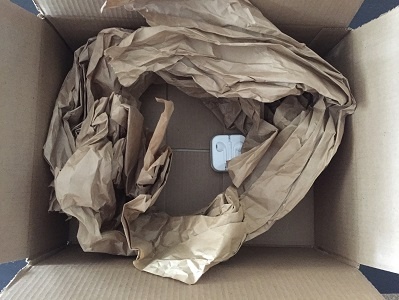 “Click.” A flash illuminates the room as your wife snaps a picture.
“Click.” A flash illuminates the room as your wife snaps a picture.
“Smile at mommy!" she encourages as your oldest daughter rips through a layer of sky-blue, snowflake wrapping paper. It’s Christmas morning, and you’ve done it again...
“Daddy, what is it!” Your kids will NEVER guess what you got them. Yes, that box she’s unwrapping may be big enough for an 80” flat screen TV, but it certainly doesn’t hold one. Stacked neatly in one corner of that box is a new pair of soccer cleats. The rest is full of tissue paper. It never gets old.
You’ve been disguising your kids’ Christmas presents since your oldest turned five—putting footballs in old crockpot boxes and wrapping Barbie dolls in towels so the outline isn’t obvious.
But those days are gone. Now that Christmas and birthdays are unofficial e-commerce events, the need to disguise gifts has all but disappeared. E-commerce retailers do all the work for you! Your gifts get dropped on your doorstep, pre-disguised in gargantuan boxes that could hold anything from a mattress to a paper clip. All you have to do is throw wrapping paper around it and slap on a bow.
ADMIT IT, you’ve ordered something online and had it arrive in a box 10X bigger than it needed to be. Come to think of it, the t-shirt I ordered last week showed up in a package big enough for my wife’s shoe collection (ok, there’s not a box in the world that could hold that, but you get the point). So, what gives?
WHAT’S WITH ALL THE GIGANTIC BOXES?
Bigger is better, right? Wrong—at least in the business of shipping. But, why then did that spatula you ordered for grandma get shipped in a box fit for a bicycle? We’ve been asking ourselves the same thing—so we did a little research. Here’s what we found:
1. CLOSE DOESN'T CUT IT
Most retailers aren’t in control of their entire supply chain. Matter of fact, you’ve got a better chance of finding a snow-spotted leopard in the wild than you do of discovering a company that controls all components of its supply chain.
Here’s the quick and dirty. Ecommerce retailers are getting their product from manufacturers the world over. These e-tailers count on the manufacturers to provide accurate measurement and weight data. The e-tailers need that data to efficiently slot, package, and distribute product.
Do you think those manufacturers are consistently providing accurate dimensions and weight? Yeah, neither do we. Inaccurate data translates to inaccurate box sizes, hence your unnecessarily oversized spatula box.
Accurate dimensional data is difficult to capture and use, especially for unique and odd-shaped items that are now so prevalent in ecommerce situations. The solution is a volume measurement system, also known as a dimensioning or cubing system.
Dimensioning systems that can gather accurate measurements and weight on almost any item provide immeasurable value to manufacturers and retailers alike. See the technology first hand.

Before you keep reading, think about your warehouse, distribution center, shipping station, etc. What kind of difference could accurate dimensional data make in your operation?
2. BURIED IN BOXES
Ecommerce is taking over the world. Don’t believe me? Go read a few articles about drones delivering packages to your doorstep within 30 minutes of placing your order, then come talk to me.
Because ecommerce is the present AND the future, e-tailers are working hard and fast to improve their direct-to-home delivery methods. A big part of their push is standardized packaging.
Think about it:
If you were running a warehouse or distribution center, what would you rather deal with?
Five standard-size boxes or fifty?
Taking the time to find the right box among fifty different versions would end up costing more than shipping a box of mostly air. Retailers are happy to ship you a small item in a huge box as long as it means they don’t have to break stride. Standardized boxes are easier to stack and easier to move.
 Fortunately, technology exists that allows you to have your cake and eat it too. A good dimensioning system will measure and weigh your items, as well as tell you the exact dimensions of the smallest box that would fit all your items. Integrating accurate dimensional data with an on-demand packaging system (such as Packsize) ensures that all your orders are packaged and shipped the way they should be—snug, with the perfect amount of packaging material and protection.
Fortunately, technology exists that allows you to have your cake and eat it too. A good dimensioning system will measure and weigh your items, as well as tell you the exact dimensions of the smallest box that would fit all your items. Integrating accurate dimensional data with an on-demand packaging system (such as Packsize) ensures that all your orders are packaged and shipped the way they should be—snug, with the perfect amount of packaging material and protection.
Don’t take my word for it, see for yourself.
3. AIN'T NOBODY GOT TIME FOR THAT
Speed, speed, speed. Even Usain Bolt would have a tough time keeping up with ecommerce shipping and order fulfillment these days. E-tailers can’t afford to get behind—every second counts in getting a package delivered on time. And we all know that on-time delivery has a strong correlation with repeat business. Retailers don’t think they can afford to add another step to the process, and as a result you are burdened with a lot of extra cardboard.
Sounds like a worthy tradeoff for a retailer, sacrificing an overqualified box and a few floundered dollars of empty air for improved customer retention.
But here’s the thing, the tradeoff isn’t necessary! Dimensional measuring equipment is available that can measure and weigh uncommon, unusual, and uncharacteristic items such as t-shirts, polybags, and books within a matter of seconds. This dimensional equipment can fit right in with your receiving, packaging, or shipping station, increasing your productivity and accuracy without hampering the speed of your operation. Pair your new dimensional data with an on-demand packaging system and you’ve got a winning combination for quick and efficient warehousing, packaging, and distribution.
So, there you have it. The next time you get a ballpoint pen shipped in a fridge-sized box, you know why—inaccurate dimensions, standardized box sizes, and a lack of time. Dimensional data captured with speed and accuracy is the next step in improving ecommerce packaging and fulfillment.

